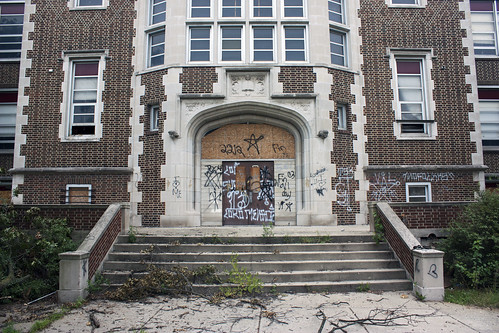"Its city center is near deserted by day. The texture of the urban landscape is cracked stone, glass, crumbled brick and buddleia."
In 1906, on the sand dunes at the edge of Lake Michigan, just 30 miles southeast of Chicago, grew a city that would once be home to the biggest steel plant in the world. It's name? Gary, Indiana.

Photo of men staking out town of Gary, Indiana courtesy nwigs.org.
Named after United States Steel CEO Albert Gary, the new plant would be called Gary Works. Aided by the transcontinental railroad, goods were shipped from Gary to the east coast relatively easily. US Steel was able to find workers quickly with the arrival of immigrants from Europe, particularly Italy, Greece, Poland and Russia at the train station.

Gary, Indiana train station abandonned in the 1950's courtesy blurb.com.
By the 1920's migrants came from the Deep South (Blacks) and Mexico. Gary's population bloomed to 55,000. Steel production soared and the metropolis was dubbed "The City of the Century". One citiizen started an experimental "Platoon School" for the immigrant children in an effort to not only educate them but Americanize them.

The Palace Theater courtesy bigbenzine.com.
But with the Stock Market Crash of 1929, the Gary Works plant's capacity plummeted from 100% to 15% within three years. Labour unrest followed. Fortunately, by the latter half of the 1930's, the steel workers' wages increased by 27%.
With the advent of the Second World War, the Gary Works plant was back at full capacity. Steel production peaked at 35 million tons in 1953. Gary, Indiana's population also peaked by the end of the decade at almost 180,000 people.

City Methodist Church courtesy flickr.com.
However, what started the slow demise of Gary was was the U.S. Steel strike which hit in 1959. Lasting 116 days, buyers started to look elsewhere for their steel including overseas. When the strike was settled, it was too late. Foreign competition won out.
A black mayor was elected in 1967. But given his colour, and given his confrontational style, many Whites and White businesses left for the suburbs. Gary started to get the reputation of being a troubled town faced with serious problems: segregation, labour unrest, industrial pollution and political corruption.

U.S. Steel courtesy media.treehugger.com.
Attempts were made to throw money at the situation including opening the Genesis Convention Center in 1982 and two casinos on the lakefront in the 1990's. But unemployment still soared. While U.S. Steel employed 30,000 workers in the late 1960's, by 1987 they employed less than 6000. The division between the races widened: While in 1920 Gary was almost 100% White, by 1990, it was 80% Black.

Horace Mann School courtesy flickr.com.
Today, Gary's literacy level is at an all time low, not helped by the fact that the public library closed in 2012. The town's population sits at 80,000, a shadow of its former self. Twenty percent of the houses sit vacant. Many historic buildings have been torn down or sit derelict. An eerie silence has fallen over Gary, a city whose streets were once filled with the hum of the steel factory.

Abandonned steakhouse courteys www.chicagogrubstree.com.
What a sad state of affairs for a town that produced the likes of astronaut Frank Borman, White Sox player Ron Kittle and the Jackson Five.

Frank Borman courtesy upload.wikimedia.org.
No comments:
Post a Comment